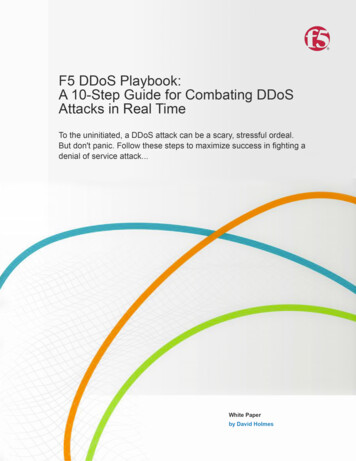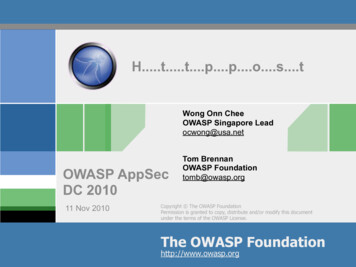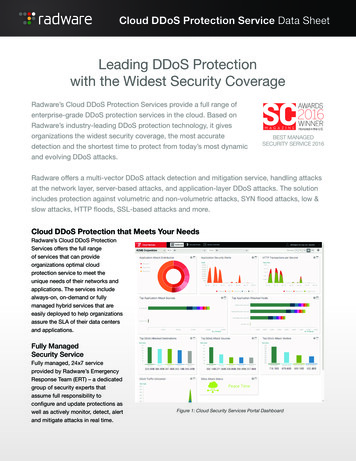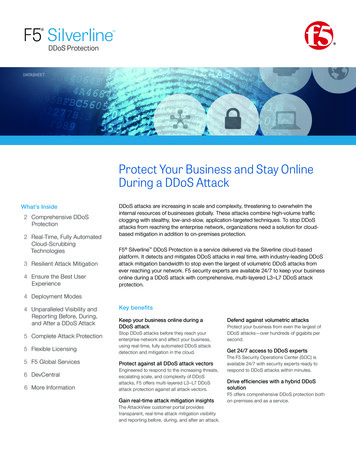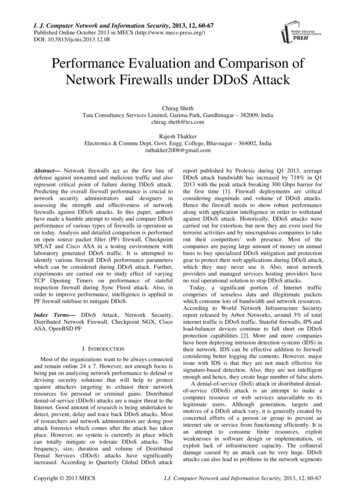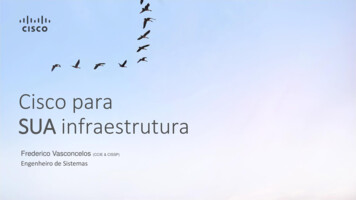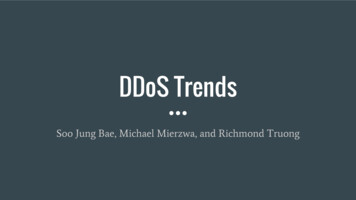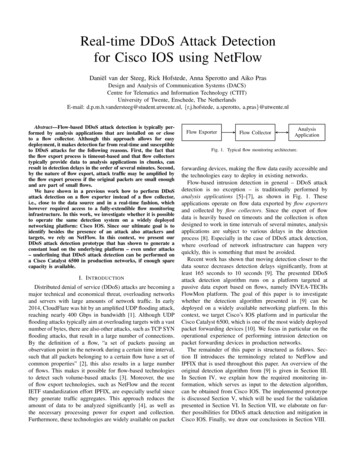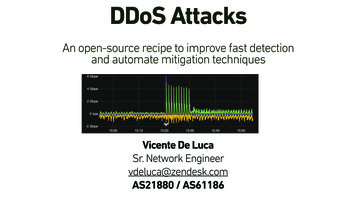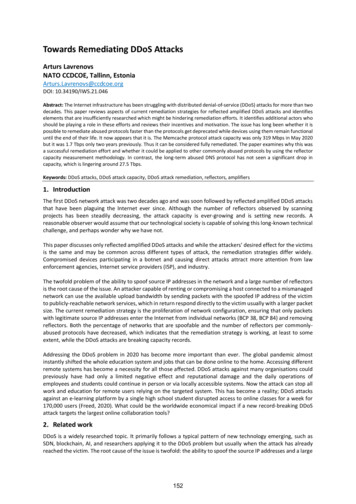
Transcription
Towards Remediating DDoS AttacksArturs LavrenovsNATO CCDCOE, Tallinn, EstoniaArturs.Lavrenovs@ccdcoe.orgDOI: 10.34190/IWS.21.046Abstract: The Internet infrastructure has been struggling with distributed denial of service (DDoS) attacks for more than twodecades. This paper reviews aspects of current remediation strategies for reflected amplified DDoS attacks and identifieselements that are insufficiently researched which might be hindering remediation efforts. It identifies additional actors whoshould be playing a role in these efforts and reviews their incentives and motivation. The issue has long been whether it ispossible to remediate abused protocols faster than the protocols get deprecated while devices using them remain functionaluntil the end of their life. It now appears that it is. The Memcache protocol attack capacity was only 319 Mbps in May 2020but it was 1.7 Tbps only two years previously. Thus it can be considered fully remediated. The paper examines why this wasa successful remediation effort and whether it could be applied to other commonly abused protocols by using the reflectorcapacity measurement methodology. In contrast, the long term abused DNS protocol has not seen a significant drop incapacity, which is lingering around 27.5 Tbps.Keywords: DDoS attacks, DDoS attack capacity, DDoS attack remediation, reflectors, amplifiers1. IntroductionThe first DDoS network attack was two decades ago and was soon followed by reflected amplified DDoS attacksthat have been plaguing the Internet ever since. Although the number of reflectors observed by scanningprojects has been steadily decreasing, the attack capacity is ever growing and is setting new records. Areasonable observer would assume that our technological society is capable of solving this long known technicalchallenge, and perhaps wonder why we have not.This paper discusses only reflected amplified DDoS attacks and while the attackers’ desired effect for the victimsis the same and may be common across different types of attack, the remediation strategies differ widely.Compromised devices participating in a botnet and causing direct attacks attract more attention from lawenforcement agencies, Internet service providers (ISP), and industry.The twofold problem of the ability to spoof source IP addresses in the network and a large number of reflectorsis the root cause of the issue. An attacker capable of renting or compromising a host connected to a mismanagednetwork can use the available upload bandwidth by sending packets with the spoofed IP address of the victimto publicly reachable network services, which in return respond directly to the victim usually with a larger packetsize. The current remediation strategy is the proliferation of network configuration, ensuring that only packetswith legitimate source IP addresses enter the Internet from individual networks (BCP 38, BCP 84) and removingreflectors. Both the percentage of networks that are spoofable and the number of reflectors per commonly abused protocols have decreased, which indicates that the remediation strategy is working, at least to someextent, while the DDoS attacks are breaking capacity records.Addressing the DDoS problem in 2020 has become more important than ever. The global pandemic almostinstantly shifted the whole education system and jobs that can be done online to the home. Accessing differentremote systems has become a necessity for all those affected. DDoS attacks against many organisations couldpreviously have had only a limited negative effect and reputational damage and the daily operations ofemployees and students could continue in person or via locally accessible systems. Now the attack can stop allwork and education for remote users relying on the targeted system. This has become a reality; DDoS attacksagainst an e learning platform by a single high school student disrupted access to online classes for a week for170,000 users (Freed, 2020). What could be the worldwide economical impact if a new record breaking DDoSattack targets the largest online collaboration tools?2. Related workDDoS is a widely researched topic. It primarily follows a typical pattern of new technology emerging, such asSDN, blockchain, AI, and researchers applying it to the DDoS problem but usually when the attack has alreadyreached the victim. The root cause of the issue is twofold: the ability to spoof the source IP addresses and a large152
Arturs Lavrenovsnumber of reflectors on the Internet. Researchers tend to focus on these aspects. The Center for Applied InternetData Analysis is running a long term project known the Spoofer to assess and monitor networks that allow theinjection of packets with spoofed IP addresses (Beverly and Bauer, 2005). The notification efforts are trackedand provide a correlation between sent notifications and remediation, thus having a positive effect on networksecurity, especially in the case of reflected DDoS attacks (Luckie et al., 2019). There have been attempts to filterspoofed packets by technical means without remediating the mismanaged networks (Jin et al., 2003; Mirkovicet al., 2017) but while those might demonstrate high efficiency in a simulated setting, this approach has not seenwidespread adoption.Reflector research is quantitative. It revolves around scanning the Internet for a specific port and protocolabusable for reflection. It is conducted when a protocol starts being abused (Czyz et al., 2014) or is beinginvestigated for the possibility of future abuse (Rossow, 2014). Usually, this type of research does not investigatewhat the abused devices are, or their contribution to the attack capacity. Most focuses on dealing with theconsequences instead of understanding and addressing the root causes. Osterweil et al. (2020a, 2020b) exploredthe state of affairs of DDoS attacks and recognised that fundamental changes and more research are needed totackle the issue while relying fully on the peak attack capacities reported by mitigation services providers.Global DDoS attack capacity estimation can identify which of the abused protocols contribute the most (Leverettand Kaplan, 2017) and which regions are at highest risk (CyberGreen Institute, 2020) and a proposed measuringmethodology (Lavrenovs, 2019) enables identification of the most and least contributing hosts, networks andregions. Synthetic measurements of reflector performance in a laboratory setting (Vasques and Gondim, 2019;Gondim et al., 2020), although important for furthering the understanding of global capacity, cannot cover thewhole range of devices and network conditions on the Internet.3. Actors and motivationUnderstanding some of the actors on the Internet landscape can provide clues as to why we are struggling withremediation efforts. Ordinary users merely want to access remote services offered by organisations. Maliciousactors range widely in their capabilities and motivations but ultimately seek to prevent users from accessingtargeted services. Most of the published research focuses on these types of actors, but there are others whoeither contribute to the problem or can contribute to the remediation.3.1 ISPs and transit service providersMany of the transit service providers and some of the ISP and data centres cannot filter out large application layer DDoS attacks. The motivation for this type of actor is to provide network services to all their clients whilemaintaining customer satisfaction and fulfilling service level agreements. If the attack size is not affecting otherclients, it might get passed on to the victim. The victim may or may not have the means to deal with the attack.If it is large enough to affect other clients, then the transit providers have to mitigate it, and often the onlymeans to do that is to employ blackholing as remote from the victim in network topology as possible (King etal., 2016). As the attacked service loses connectivity, the attack can be considered successful.ISPs are externalising the cost of having open reflectors on their networks. From their perspective, there mightbe no drawbacks even in network bandwidth consumption. Networks that focus on specific customer segments,such as residential or data centres usually have unbalanced network bandwidth consumption and thus unusedcapacity. When reflectors in a residential ISP network are generating amplified responses, they consume thisunused upload capacity. As long as this consumption is relatively small and does not affect other clients or thenetwork routers, there are no ill effects for the ISP and therefore no incentive to fix the problem.The targets of the DDoS attacks are often commercial services hosted in data centres and this imbalance enablesreception of attack download bandwidth without any additional expense to the extent of reserve capacity. If thefree capacity is sufficient and the network has an appropriate filtering solution, the attack can be mitigated. Thelarger the data centre is, the more free capacity its network might have meaning larger attacks could be filteredout. Some of the largest data centres in the world do offer DDoS filtering at little or no cost and can handle mostof the attacks. Smaller data centres and ISPs can be overwhelmed by a single attack.If an ISP has balanced bandwidth either by offering services to both bandwidth generating and consumingclients or by selling unused capacity as a transit, it can have financial incentives and thus motivation to keep153
Arturs Lavrenovswasted bandwidth to a minimum. Technical solutions or network monitoring and management can significantlyreduce wasted bandwidth for the ISP.No legislation specifically targets the negligence of having open reflectors present on the networks, and even ifa DDoS attack from a specific set of reflectors caused provable damage, the liability could be shifted to the end client hosting these reflectors. Overall, a significant number of ISPs that host open reflectors have no motivationto address this issue.3.2 Mitigation service providersDDoS mitigation services often attract the largest attacks on the Internet. These service providers mightexclusively offer DDoS filtering or accompany it with CDN or other network services. The business model isstraightforward; acquire ingress bandwidth capacity that exceeds the largest expected attacks and deploy afiltering solution that can drop the attack traffic while forwarding the legitimate packets to the client.Whenever a new protocol is abused or a new attack size record is broken, these providers publish a technicalreport. These reports are the most referenced sources for DDoS capacity and largest attacks in academia,industry, and media, making them excellent sources of free worldwide marketing.As long as expected attack capacity and future growth are manageable and no record breaking attacks happen,these providers are in a safe market position. They have the most technical insights into the current situationand what needs to be addressed first. However, remediating it is not in their interest as they will lose competitiveadvantage or even their entire business model.3.3 Device manufacturersOften overlooked is that a large number of reflectors are not essential public services but rather residential andbusiness devices with default configurations connected to the Internet. The problem is exacerbated by the classof devices that have router functionality with separate internal and external network interfaces. Services on theinternal interface might be required, but they are not contributing to the open reflector problem while serviceson the external interface could contain open reflectors but generally are not needed for functionality requiredby users.Residential device manufacturers often seek to make their products as cheap as possible and this is sometimesachieved by cutting corners; software quality and security have been first to suffer. If a device is compromisedbecause the default configuration control panel exposed to the Internet and default credentials or a vulnerabilityin the software were exploitable, then it may at the very least become part of the botnet. Users of these devicesmight not even notice, or they might wonder why the CAPTCHAs have become more frequent or why theInternet sometimes slows down. In more extreme cases, the user’s information could be stolen or furtherexploitation conducted to take over other devices on the network. If mass exploitation of a manufacturer’sdevices with tangible consequences for the users occurs, it will attract bad publicity. Manufacturers are thusincentivised to minimise such occurrences and fix them so they do not recur. A large number of devices operatingas open reflectors do not harm customers directly, but the reputational damage will motivate the manufacturerto address the issue.3.4 Policymakers and legislaturesIn all developed countries, causing a DDoS attack already falls under some criminal ordinance. Malicious actorsresponsible for reflected DDoS attacks are the hardest to identify. The global nature of the Internet and DDoSattacks could mean a single attack against a company registered in one jurisdiction could be affecting servicesphysically hosted in one or more other jurisdictions and caused by an attacker located in another who usesspoofing and reflectors located in any number of other jurisdictions. While charging criminals and affectinginternational law is a challenge, legislatures and regulators seek to improve their citizens’ lives and should beencouraged to remediate DDoS attacks.4. Remediating DDoS attacksThe most visible remediation efforts scan for open reflectors targeting the source networks and notify networkadministrators. Other simple solutions might also be available.154
Arturs Lavrenovs4.1 Notifying network administratorsMuch academic and industry research has focused on conducting scans for known abused services reachable onthe Internet and notifying network or abuse contacts. If the network is properly managed, these notices areforwarded to the end client and maybe the client is even assisted with solving the issue. Perhaps the networkhas specific terms of service that mandate clients to limit or block their reflectors. Poorly managed networks donot even forward these notices. While running reflector honeypots, we have encountered a large number offorwarded notices on some of the well managed networks, but their effectiveness might be limited.The number of reflectors for long abused protocols seems to be decreasing, but it is unclear the role thatnotification efforts have played. There is no research into this, and thus no reliable assertion can be made. Analternative explanation is that devices that are abusable are present on the Internet until the end of their lifetimeor until network configuration changes and the effect is completely detached from any remediation efforts.The repetitive nature of the notification e mails combined with the lack of any perceived value for the networksmakes its effectiveness questionable. Providing an estimate of potentially wasted bandwidth capacity calculatedfor each network can offer at least some perceived value. Measuring the effect of this remediation approach isnot easy, but a detailed report hidden by tracked link and capacity changes in the specific network over timeagainst the baseline could provide insights into its effectiveness.4.2 ISPs and net neutralityAlthough net neutrality has been a hot topic for several years, there are widespread precedents of it beingviolated in some protocols for the benefit of ISPs. While DPI and traffic shaping in residential and mobilenetworks have been widely investigated, the lesser known and measured practice of ISPs and data centresblocking or limiting specific ports has not. Most commonly, it targets e mail sending ports and blocks them bydefault with an opt out ability, rate limiting or filtering system. Why client perception differs between these twocases is open for debate; it could be that an opt out feature is viewed as sufficient choice.Spam was a problem even before reflected DDoS attacks became a norm. As it directly affects the productivityand safety of the users and businesses, various mitigation approaches have been developed, primarily spamfiltering and blacklisting compromised hosts. However, spam filtering is not 100% precise and neither is blockingindividual IP addresses of compromised hosts. If the network administrator does not take action against aspamming host, the same will happen with other spam sending hosts on the same network. Blacklisting thewhole network or decreasing its reputation seems a reasonable step to protect users and as individual blacklistmanagement is time consuming, global blacklists are used by many e mail services.If ISPs wish to offer clients the ability to directly send e mails that are not rejected or classified as spam by mostreceivers, they have to keep themselves off the blacklist. Whenever an abusive host appears on the network,swift action has to be taken to stop spamming by limiting network connectivity or asking the client to solve theissue. Otherwise, clients cannot send e mails and thus ISP can only have clients that do not need thatfunctionality. Most ISPs elect to deal with the spam issue to avoid being added to the blacklists.Some ISPs externalise the costs of poor network management practices and have no incentive to act otherwise.They might be susceptible to persuasion to improve the management of their networks using the blacklistingapproach that is used to fight spam but that would depend on the cost of being added to the blacklist. There arealready other blacklists besides the spam ones. Usually, they consist of individual hosts (or small subnets) whosebehaviour is deemed malicious, such as spreading malware, aggressive scanning, probing services, or brute forcing credentials. These blacklists are often deployed by governmental or other organisations striving for moresecurity. Surprisingly, this might not penalise the ISP at all as non abusive clients might not experience anylimitations. Combined with the fact that reflectors are not malicious and blacklisting them is pointless, thisapproach seems unsuitable as a mitigation strategy.The offences discussed above could decrease the overall reputation of the network. Greylisting the whole ISPbased on its reputation can be effective as it affects many clients. A few hosts brute forcing credentials mightforce websites that rely on network reputation to require all ISP clients to always solve a CAPTCHA. Credit cardtransactions or other activity might be delayed for manual processing or fail by default as labelled potentiallyfraudulent. Client satisfaction could drop and they could look for another ISP which would provide a financial155
Arturs Lavrenovsincentive. Relying on the same greylists could be done for networks that allow spoofed IP packets and only if itcould be proven that the spoofing was actively happening.We might need a new type of greylist for DDoS reputation and a way to penalise ISPs. The penalty should berelevant to the DDoS issue; for example, the same CAPTCHA that many DDoS mitigation services employ couldpenalise a network known to allow spoofed packets or which contains a disproportionately high number of openreflectors.Whenever there is a discussion requiring third parties to implement a new regulation, there is always a questionof cost. It happens with ISPs whenever national governments require expensive DPI or data retention systems.Basic solutions for both blocking packets addressed to reflectors and IP address spoofing are simple and cheap.Blocking all packets coming from the Internet addressed to a few known abused ports is trivial and cost free foran ISP on existing equipment. The only incurred cost is in managing or providing self service functionality forclients to opt out.4.3 Devices and regulationOpen reflectors running on consumer devices is something we can start addressing now. The California statelegislature has passed an act (State of California, 2018) requiring connected devices to have basic securitymeasures to protect consumers. While this does not directly affect the consumer, there is no reason why thistype of legislation could not improve overall security on the Internet by requiring external interfaces to notprovide any unneeded services by default. If this regulation in at least one large market is introduced rationally,it would be more cost effective for manufacturers of those devices to supply the same secure version to allmarkets.While a legislature could also require ISPs to offer a basic firewall with an opt out feature, it would not have aslarge an effect in other jurisdictions. As patching of consumer devices is done rarely, the old ones might continuecontributing reflector capacity until end of life without ISP regulation.To start addressing the issue from the device perspective, we need to understand which device classes andmanufacturers contribute the most to the capacity. Then, the most prominent manufacturers can be addresseddirectly and this knowledge can be presented to legislatures to justify actions. Only if national legislation hasproven to be effective is it justifiable to lobby for international laws and regulations.5. Measuring DDoS attack capacityUnderstanding DDoS attack capacity is necessary for developing and validating more efficient remediationstrategies and it is one piece of information that current DDoS research is lacking. We have used the proposedmethodology (Lavrenovs, 2019) to measure two very dissimilar abused protocols: Memcache and DNS.5.1 MemcacheMemcache has been the record holder for DDoS attack size since 2018 with a reported observed attack capacityof 1.7 Tbps (Morales, 2018). We measured its attack capacity to be only 319 Mbps in May 2020, contributed byonly 12 reflectors which could have been aggressive honeypots. The measuring methodology allows theexclusion of insignificantly contributing hosts from the calculation. Therefore, the protocol can be consideredfully mitigated and likely will not see a resurgence. Because of how capacity is understood, decision makers andthe public could wrongly assume that the currently most referenced number in terms of capacity is relevant. Forhow long this protocol and attack size has been wrongly considered a major concern?How fast was this protocol remediated? The same way as the peak attack is observed in a specific network andpoint in time a singular measurement is no different. The solution is to have a system continuously measuringattack capacity for each actively abused protocol where newly abused protocol monitoring could be addedquickly.This protocol is a noteworthy case not only because of the record attack size but also because of the fastremediation and deployment differences. Most of the long term abused protocols are present on low powerconsumer devices reachable on the Internet. Memcache was generally deployed in the enterprise environment156
Arturs Lavrenovswhere each host could have gigabit on 10 gigabit connectivity. The protocol is providing high performanceservice, meaning the software was not a bottleneck either. Each reflector could fill the available bandwidthcapacity, negatively affecting its primary functionality which could then be detected by the administrators.Notification efforts could also reach responsible administrators that have the incentive and capability to actupon it. As this protocol affected mitigation service providers, they actively participated in remediation efforts(Majkowski, 2018).5.2 DNSDNS remediation differs significantly. It was one of the first protocols abused in the wild for reflected amplifiedDDoS attacks and to this day remains unremediated. In May 2020, the DNS protocol global capacity wasmeasured to be 27.5 Tbps (80% required minimum response rate, 1 Gbps per country minimum capacity; seeFigure 1). This type of presentation is common for capacity estimation providing more detailed information thanpure open reflector counts. It identifies China and the USA as the largest capacity contributors followed bydeveloping and developed countries with high speeds of Internet connectivity.Figure 1: DNS attack capacity per countryThis figure corresponds closely to our 2018 August measurement of 37.6 Tbps. While this might seem like asignificant decrease, network churn, positioning of measurement points in the network topology and lack ofestablished methodology for addressing measurement errors must all be considered. Even if we assume themeasurements are comparable and have insignificant measurement errors, the change over time is low relativeto the fully mitigated Memcache.According to Cloudflare, the top two networks sending reflected Memcache packets were OVH and DigitalOcean, both of which conducted remediation work (Majkowski, 2018), possibly network firewalling thereflectors or making direct contact with clients. These networks are still major contributors to DNS protocolabuse with 1.4 Tbps and 200 Gbps of measured DNS reflection capacity respectively. They provide data centreand hosting services and should value their outgoing bandwidth capacity while understanding the effect as theyare prime targets for the attacks themselves. This suggests that the type of ISP where the reflectors reside is notthe determining factor in the remediation outcome, or not the only one. The reason for the remediationoutcome difference may be a combination of factors – low reflector count, high connection bandwidth or, forMemcache, positioning in non residential networks. This could significantly incentivise some actors, but there iscurrently no empirical evidence to support the theory.157
Arturs Lavrenovs6. Results and discussionWe know two root causes enabling reflected DDoS attacks and the appropriate technical remediation – eliminateopen reflectors or IP spoofing, or both. However, we cannot implement these measures universally andinstantly. Quantitatively, the remediation works on both fronts but is hampered by ever increasing bandwidthcapacity. We need to improve the remediation strategy, starting with adjustments requiring minimal effort andencountering no resistance to produce an incremental positive effect. We reviewed some additional actors (ISPs,device manufacturers, and legislatures) that should be part of the remediation strategy but lack incentives andthus motivation. The block for all of them is a lack of understanding of attack capacity and therefore the abilityto measure improvements and estimate the effectiveness of any new measures taken. Mitigation serviceproviders have monopolised this knowledge and have disincentives to improve the situation. We have confirmedthrough capacity measurements that full remediation is possible for a highly abused protocol (Memcache) withina reasonable timeframe which has not been observed before for other protocols. In contrast, DNS remediationhas been stagnating from the capacity perspective over the last two years.We have raised many issues that can be addressed with comprehensive research into the root causes of DDoSattacks instead of their effects. Capacity research and understanding is key to measuring the effectiveness ofremediation efforts and validating proposed and possible future remediation strategies. We need to measurethe capacity contributions of specific ISPs and device manufacturers to include this with the notification effortsand measure the impact of these efforts. We also need to justify any legislative efforts with reliable andindependent data.ReferencesBeverly, R. and Bauer, S. (2005) The Spoofer project: Inferring the extent of source address filtering on the Internet, inUsenix Sruti, pp. 53–59.CyberGreen Institute (2020) ‘Cyber Health Statistics’. URL https://stats.cybergreen.net/ (accessed 9.19.2020).Czyz, J. et al. (2014) Taming the 800 pound gorilla: The rise and decline of NTP DDoS attacks, in Proceedings of the 2014Conference on Internet Measurement Conference. ACM, pp. 435–448.Freed, B. (2020) Miami high schooler charged in DDoS attacks against district. URL https://edscoop.com/miami dade schools ddos attack student charged/ (accessed 4.9.2020).Gondim, J. J. C., de Oliveira Albuquerque, R. and Orozco, A. L. S. (2020) Mirror saturation in amplified reflection DistributedDenial of Service: A case of study using SNMP, SSDP, NTP and DNS protocols, Future Generation Computer Systems.Jin, C., Wang, H. and Shin, K. G. (2003) Hop count filtering: an effective defense against spoofed DDoS traffic, inProceedings of the 10th ACM conference on Computer and communications security. ACM, pp. 30–41.King, T. et al. (2016) BLACKHOLE Community. RFC7999. RFC Editor, p. RFC7999.Lavrenovs, A. (2019) Towards Measuring Global DDoS Attack Capacity, in 2019 11th International Conference on CyberConflict (CyCon). 2019 11th International Conference on Cyber Conflict (CyCon), Tallinn, Estonia: IEEE, pp. 1–15.Leverett, E. and Kaplan, A. (2017) Towards estimating the untapped potential: a global malicious DDoS mean capacityestimate, Journal of Cyber Policy, 2(2), pp. 195–208.Luckie, M. et al. (2019) Network Hygiene, Incentives, and Regulation: Deployment of Source Address Validation in theInternet, in Proceedings of the 2019 ACM SIGSAC Conference on Computer and Communications Security. CCS ’19:2019 ACM SIGSAC Conference on Computer and Communications Security, London United Kingdom: ACM, pp. 465–480.Majkowski, M. (2018) Memcrashed Major amplification attacks from UDP port 11211, Cloudflare. URLhttps://blog.cloudflare.com/memcrashed major amplification attacks from port 11211/ (accessed 3.3.2018).Mirkovic, J., Kline, E. and Reiher, P. (2017) RESECT: Self Learning Traffic Filters for IP Spoofing Defense, in Proceedings ofthe 33rd Annual Computer Security Applications Conference. ACM, pp. 474–485.Morales, C. (2018) NETSCOUT Arbor Confirms 1.7 Tbps DDoS Attack; The Terabit Attack Era Is
Keywords: DDoS attacks, DDoS attack capacity, DDoS attack remediation, reflectors, amplifiers 1. Introduction The f irst DDoS n etwork at tack was t wo d ecades ago an d was s oon followed b y re flected a mplified DDoS at tacks that have been plaguing the Internet ever since.
